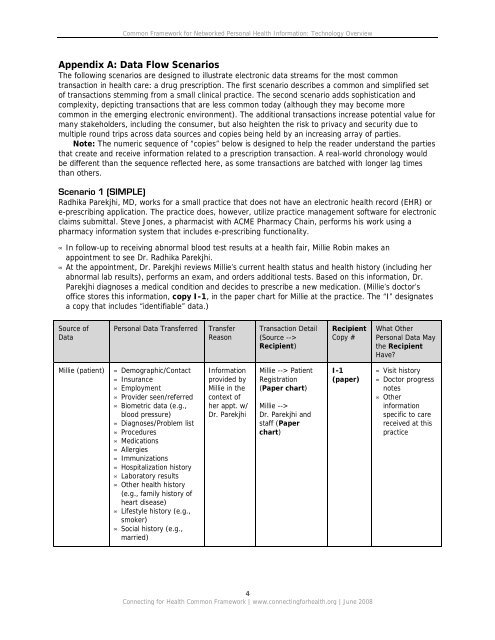CF-Consumers-Full
CF-Consumers-Full
CF-Consumers-Full
Create successful ePaper yourself
Turn your PDF publications into a flip-book with our unique Google optimized e-Paper software.
Common Framework for Networked Personal Health Information: Technology Overview<br />
Appendix A: Data Flow Scenarios<br />
The following scenarios are designed to illustrate electronic data streams for the most common<br />
transaction in health care: a drug prescription. The first scenario describes a common and simplified set<br />
of transactions stemming from a small clinical practice. The second scenario adds sophistication and<br />
complexity, depicting transactions that are less common today (although they may become more<br />
common in the emerging electronic environment). The additional transactions increase potential value for<br />
many stakeholders, including the consumer, but also heighten the risk to privacy and security due to<br />
multiple round trips across data sources and copies being held by an increasing array of parties.<br />
Note: The numeric sequence of “copies” below is designed to help the reader understand the parties<br />
that create and receive information related to a prescription transaction. A real-world chronology would<br />
be different than the sequence reflected here, as some transactions are batched with longer lag times<br />
than others.<br />
Scenario 1 (SIMPLE)<br />
Radhika Parekjhi, MD, works for a small practice that does not have an electronic health record (EHR) or<br />
e-prescribing application. The practice does, however, utilize practice management software for electronic<br />
claims submittal. Steve Jones, a pharmacist with ACME Pharmacy Chain, performs his work using a<br />
pharmacy information system that includes e-prescribing functionality.<br />
• In follow-up to receiving abnormal blood test results at a health fair, Millie Robin makes an<br />
appointment to see Dr. Radhika Parekjhi.<br />
• At the appointment, Dr. Parekjhi reviews Millie’s current health status and health history (including her<br />
abnormal lab results), performs an exam, and orders additional tests. Based on this information, Dr.<br />
Parekjhi diagnoses a medical condition and decides to prescribe a new medication. (Millie’s doctor’s<br />
office stores this information, copy I-1, in the paper chart for Millie at the practice. The “I” designates<br />
a copy that includes “identifiable” data.)<br />
Source of<br />
Data<br />
Personal Data Transferred<br />
Transfer<br />
Reason<br />
Transaction Detail<br />
(Source --><br />
Recipient)<br />
Recipient<br />
Copy #<br />
What Other<br />
Personal Data May<br />
the Recipient<br />
Have?<br />
Millie (patient)<br />
• Demographic/Contact<br />
• Insurance<br />
• Employment<br />
• Provider seen/referred<br />
• Biometric data (e.g.,<br />
blood pressure)<br />
• Diagnoses/Problem list<br />
• Procedures<br />
• Medications<br />
• Allergies<br />
• Immunizations<br />
• Hospitalization history<br />
• Laboratory results<br />
• Other health history<br />
(e.g., family history of<br />
heart disease)<br />
• Lifestyle history (e.g.,<br />
smoker)<br />
• Social history (e.g.,<br />
married)<br />
Information<br />
provided by<br />
Millie in the<br />
context of<br />
her appt. w/<br />
Dr. Parekjhi<br />
Millie --> Patient<br />
Registration<br />
(Paper chart)<br />
Millie --><br />
Dr. Parekjhi and<br />
staff (Paper<br />
chart)<br />
I-1<br />
(paper)<br />
• Visit history<br />
• Doctor progress<br />
notes<br />
• Other<br />
information<br />
specific to care<br />
received at this<br />
practice<br />
4<br />
Connecting for Health Common Framework | www.connectingforhealth.org | June 2008



